Gibanica – a Serbian recipe for a delicious layered cheese pie or cheese pita made with phyllo or yufka dough and lots of cheese.
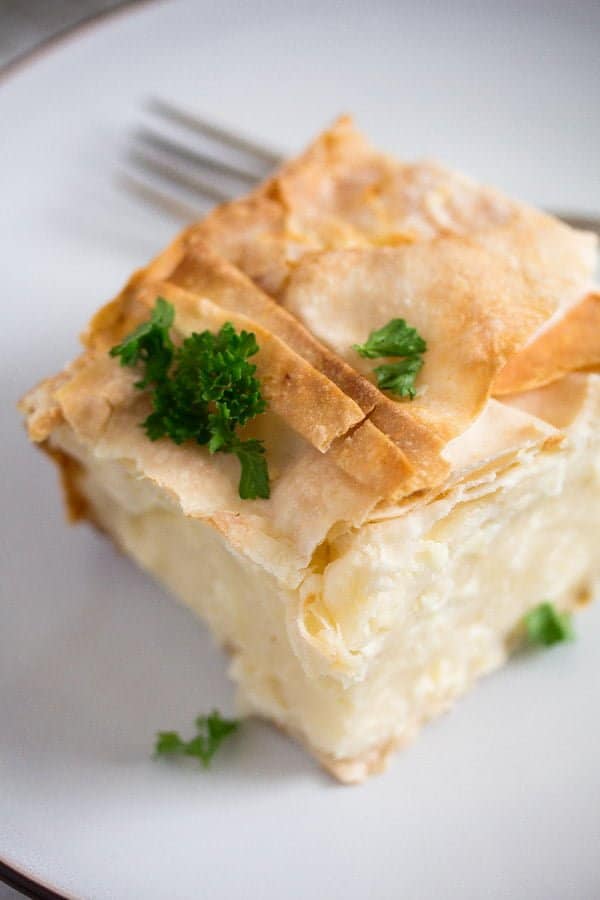
Gibanica is one of the most popular dishes in Serbia. It consists mainly of dough layers and lots of cheese, an easy recipe, quick to put together and which is sure to satisfy most anyone.
This amazing Gibanica is one of the best cheese pies I have ever made, similar to my own Savory Cheese Pie with Quark, Feta, and Yogurt, yet somehow different. You will just love those pastry layers filled with that salty and comforting cheese, everything so soft and satisfying.
Featured comment:
Elaine: We are Greek, and my late mom used to make something just like this. I didn't even know what it was called, and I assumed I'd never get to have it again after she passed away. I started googling, and eventually came up with your recipe as maybe the closest one. It really turned out super, and it wasn't too difficult for an American like me. Thank you. I'm bringing it to Thanksgiving dinner tomorrow.
Jump to recipe
What is Gibanica?
Gibanica is a trademark in Serbian cuisine. You can buy this savory cheese pie on every corner, it is baked in every family, there are even festivals dedicated to gibanica. Other former Yugoslavian countries have their own versions of gibanica, but the Serbians claim their version to be the true and original gibanica.
Gibanica can be eaten at any celebration in Serbia, not only for Christmas or Easter, for instance, but at weddings, parties, and so on, especially if they have a traditional touch. In these situations, it is mainly served as an appetizer.
However, it is not only eaten as an appetizer. If you choose to eat it on the street, you will take it on the hand and have it as a snack. Many Serbians eat it for breakfast with some yogurt. Or you could have it for lunch as a first course or in the evening as well. Gibanica can be served hot or cold, it can be reheated, and it keeps quite well in the fridge for a few days.
Recipe ingredients
Pastry: I used yufka pastry, which is very easily available in all the Turkish shops in Germany, but if you cannot find it, filo pastry will do just as well. I had a large package that contained 15 sheets of approximately 43x30 cm/ 17x20 inches. You do not need exactly these same sizes; more or less is OK.
- Phyllo or strudel dough can be substituted. I used the whole packet of dough, but I used as many dough sheets as needed to fill and cover the pie. Leftover dough should be very well packed and used within a few days.
- More yufka/phyllo recipes: Albanian Spinach Rolls, Hungarian Noodle Cheese Pie, and Skinny Filo Pumpkin Pie.
Cheese: The Serbians use a traditional white cow's cheese, which can be bought there at farmer's markets and which gives the gibanica its specific taste. However, as that kind of cheese is not available outside this region, substitutes had to be found.
- I substituted the typical cheese with a mixture of cow's feta cheese, cottage cheese, sour cream, and whole milk.
Other ingredients: Sour cream, cottage cheese, whole milk, eggs, olive oil, and fine sea salt.
See the recipe card for full information on ingredients and quantities.
How to make this gibanica recipe?
Filling: Mix the filling ingredients and add salt accordingly. The mixture will be runny. Don't worry about it; it is supposed to be like that.
Assemble:
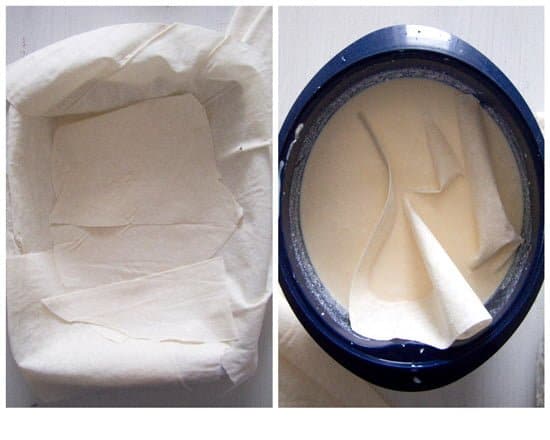
- First, line the lightly oiled baking dish with two layers of dough. The dough sheets should hang over the edges of the baking dish; when you are finished filling the pie, you will seal it using these overlapping pieces of dough.
- Place the bowl with the cheese mixture next to the baking dish. Take one dough sheet out of the packet, crumple it a bit (it doesn't matter if it breaks a little), and dip and run it through the cheese mixture.
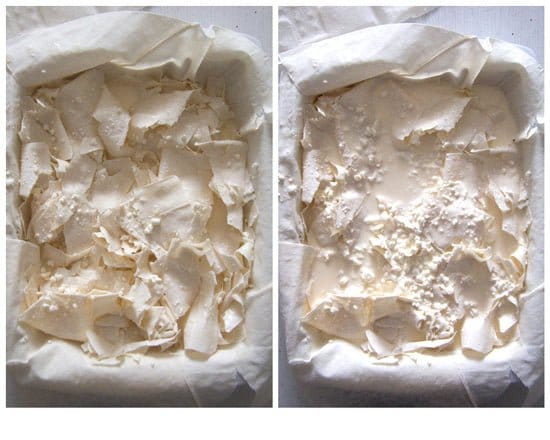
- Press it lightly into your hand to give it a rough round shape, and place this crumpled dough into the baking dish.
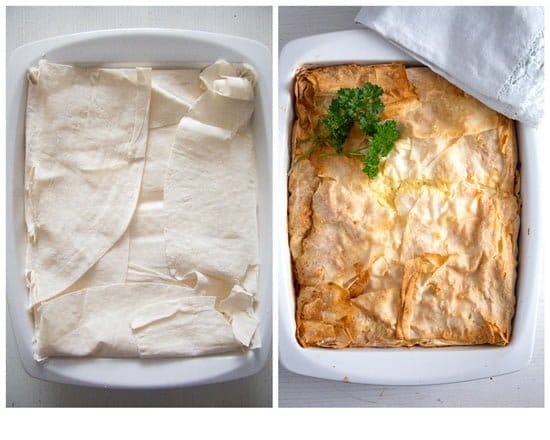
- Fold the overlapping sheets of dough over the pie. Take the last two sheets of dough and place them over the pie as well. Brush the top of the pie with a mixture of hot water and oil, and leave it to soak on the counter while you preheat the oven.
- Bake the gibanica for about 45 minutes or until golden and set.
Tips
When working with this kind of thin layer of dough, all you have to take care of is not to let the dough become dry. Only open the packet of dough after you have made the filling for the Serbian cheese pie. Have the baking dish ready as well.
Once the packet of dough is open, work rather quickly and make sure to always cover the dough you are not using with a damp towel to prevent it from drying out. Only take the dough sheets out of the packet as you need them and keep them covered otherwise.
How to serve?
As mentioned above, it can be served hot or cold. You can have it for breakfast, cold, and with some yogurt. You can have it for lunch, hot and with a salad on the side, or with some Ajvar, you can have it as a first course before a more substantial dish, or you could have it for dinner, either cold or hot.
How to store and reheat?
The gibanica can be reheated in the oven, and it keeps well for several days in the fridge.
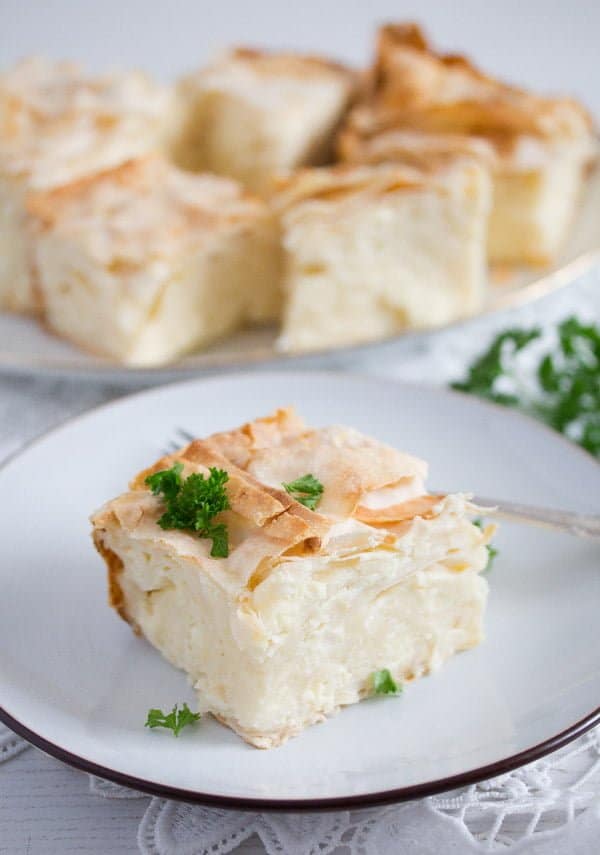
More savory pies
Recipe
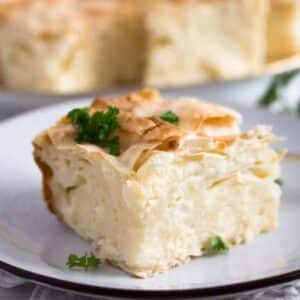
Gibanica Recipe - Serbian Cheese Pie
Equipment
- Baking dish approximately 30x22 cm/ 12x9 inches
Ingredients
- 750 g phyllo or yufka dough 1.5 lb, Note
- 350 g cow milk feta 12.5 oz
- 200 g cup sour cream ¾ cup
- 200 g cottage cheese ¾ cup
- ½ liter whole milk 2 cups
- 5 eggs
- 3 tablespoons olive oil divided
- fine sea salt to taste
Instructions
Filling:
- Roughly mash the feta cheese with a fork in a large bowl.350 g cow milk feta
- Mix: Add the lightly beaten eggs, sour cream, cottage cheese, and whole milk, and add salt to taste. The amount of salt you need depends on how salty the feta cheese is; you should definitely try the mixture and add salt accordingly.5 eggs + 200 g cup sour cream/ ¾ cup + 200 g cottage cheese/ ¾ cup + ½ liter whole milk/ 2 cups + fine sea salt to taste
Assemble the gibanica:
- Grease the baking dish with 1 tablespoon olive oil.
- Dough: Open the packet of dough and take out two sheets of dough while keeping the rest covered at all times. Cover the dough you are not working with with a damp towel to prevent it from drying out. Work quickly.750 g phyllo or yufka dough/ 1.5 lb
- First layer: Place the first two dough sheets in the greased baking dish. The dough sheets should hang over the edges of the baking dish; when you are finished filling the pie, you will seal it using these overlapping pieces of dough.
- Dip into cheese: Place the bowl with the cheese slurry next to the baking dish. Take one dough sheet out of the packet, crumple it a bit (it doesn't matter if it breaks a little), and dip and run it through the cheese mixture. Press it lightly into your hand to give it a rough round shape, and place this crumpled dough into the baking dish.
- Make sure to keep two last sheets of dough to close the pie, but otherwise, use as many pieces of dough as needed to fill the baking dish.
- Finish: Pour the remaining cheese mixture over the crumpled dough in the dish. Fold the overlapping sheets of dough over the pie. Take the last two sheets of dough and place them over the pie as well.
- Brush: Mix the remaining 2 tablespoons of olive oil and 2 tablespoons of hot water. Brush the top of the pie with this mixture and leave it to soak on the counter while you preheat the oven to 170°C/ 340°C (about 10-15 minutes).
- Bake the gibanica for about 45 minutes or until golden brown and set. Serve hot or cold as suggested above.

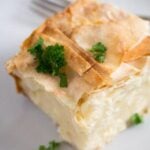
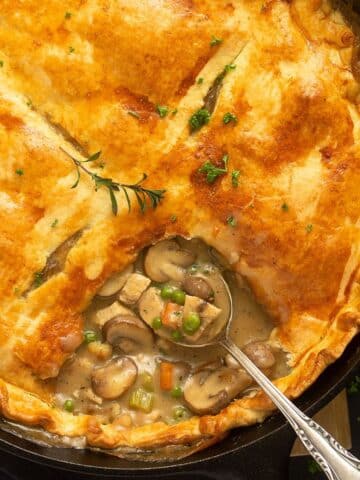
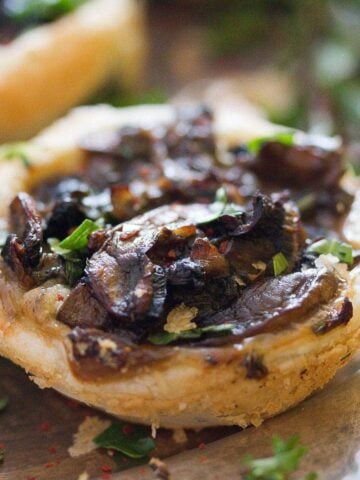
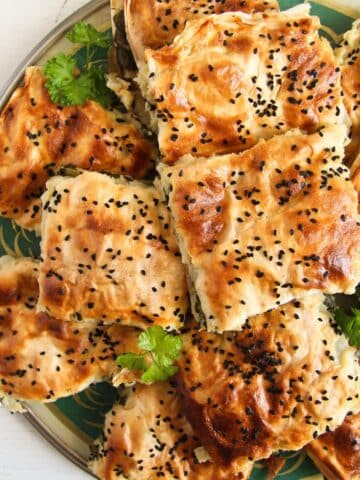
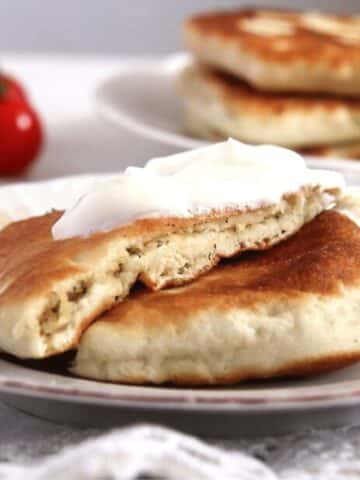
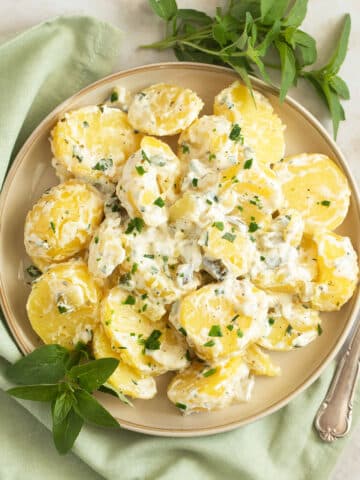

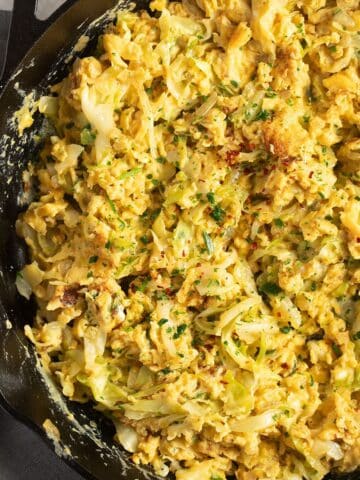
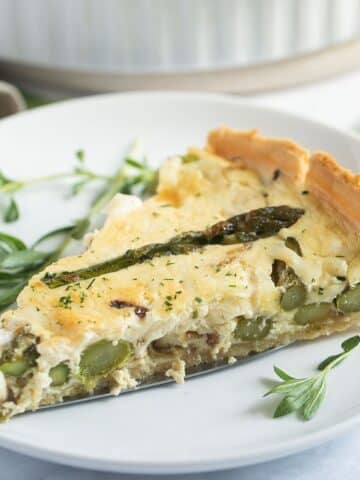

Elaine says
We are Greek, and my late mom used to make something just like this. I didn't even know what it was called, and I assumed I'd never get to have it again after she passed away. I started googling, and eventually came up with your recipe as maybe the closest one. It really turned out super, and it wasn't too difficult for an American like me. Thank you. I'm bringing it to Thanksgiving dinner tomorrow.
Paula says
Super delicious made this for dinner. Only changes I made was adding 1 sauteed leek and reducing the milk to 1 cup. For a 15 min prep this was a winner will be making it again. I prefer this recipe because it uses a lot less oil than others.
Adina says
Hi Paula. I am glad you liked it, I also like the fact that it's lower in fat.
Sil says
You mentioned BAKLAVA as Turkish,but baklava is Greek, even the word is Greek. The Turks adopted it after the conquest of Byzantium.
Adina says
Yes, it is just so widespread all over the region, I suppose all of these countries claim it as their own. As for the origin of the word, I must admit I have never checked that.
Sissi says
Beautiful pie! I remember learning about gibanica (though I've never tasted it) from a Serbian friend when we both realised Polish and Serbian "cottage/curd cheese" was exactly the same! As you know I love this cheese so I'm sure this pie is fabulous!
(PS I know one picky eating friend who is afraid of anything he hasn't eaten as a child... It's so difficult to choose a restaurant when we go out together... I cannot convince him even to try Lebanese food... though it's easier when he comes to my house: then he is less afraid of tasting new stuff!).
angiesrecipes says
Must be super yum with flaky pastry and feta! You are such a talented cook...I probably would end up damaging all the filo pastry while trying to getting through that cheese mixture.